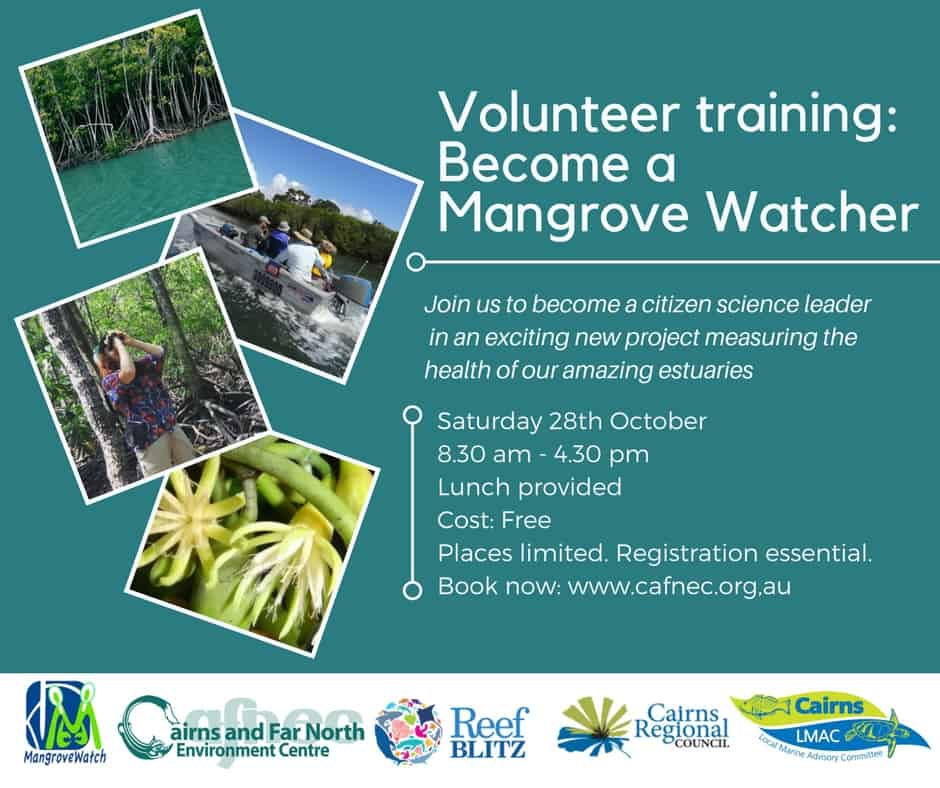This training has been and gone – check out the Mangrove Watch Cairns Chapter page for up to date information on the project.
About the training:
The Cairns and Far North Environment Centre (CAFNEC) have received funding from the Cairns Local Marine Advisory Committee (LMAC) and Cairns Regional Council to establish our very own MangroveWatch crew in the Cairns region. As a part of this years Reef Blitz we’re putting on a training day to get teams of new MangroveWatch leaders skilled up on the videographic method so we can start recording data on our local estuaries and shorelines. In this training session we will spend a few hours in the morning at CAFNEC to learn about what to do and the equipment, and half a day cruising Trinity Inlet getting the hands on low-down on how to be a MangroveWatcher. No prior skills needed.
When: Saturday 28th October 8.30 am – 4.30 pm
Who: Prof. Norm Duke, Mangrove Specialist from TropWater Centre at James Cook University (JCU), & the much-awarded Geoffrey Redman from the enthusiastic Moreton Bay MangroveWatch team. Come learn from our unique combination of expertise, experience and great stories.
Where:
- Morning classroom session 8.30 – 11.30 at Cairns and Far North Environment Centre 27-29 Greenslopes St North Cairns
- Afternoon hands on boat session at Trinity Inlet 12 – 4.30 pm
Cost: Free
Details: Simple lunch provided, BYO snacks, water bottle hat and sunscreen.
Contact Bess Murphy community@nullcafnec.org.au or 0409696939
Registrations have now closed – we’ve had a lot of interest! Contact Bess via details above to go on the waiting list, or you are welcome to attend the morning session at CAFNEC (we’ve had to cap numbers in the afternoon due to boat capacity)
Regardless, if you’d like to join the project and find out more please fill out the form below and we’ll be in touch when we are planning more training and events – you can still be involved, in fact, we’d love you to be!
[ninja_form id=56]
About MangroveWatch:
If a mangrove falls into the sea, and nobody is watching, does anybody care? The question is what if someone was watching?! MangroveWatch is a citizen-science partnership between communities, scientists and resource-managers to document changes in local mangrove habitats and inform better management of estuaries (see: www.mangrovewatch.org.au). Information about the health of shoreline ecosystems is urgently needed to inform better mangrove management and help protect North Queensland’s estuaries and tidal wetlands from unintended development pressures coupled with the impacts of global climate change.
Mangroves are indicators of environmental impact and the health of waterways: by collecting baseline data on the health of mangroves in the Cairns Region we can monitor the ecosystem over time. The MangroveWatch program is designed to be run by members of the community, who actively collect the data via. video shoreline assessment, as well as visual assessment. MangroveWatchers record mangrove habitat condition by filming mangrove shorelines using the Shoreline Video Assessment Method (S-VAM). The S-VAM imagery is a geotagged visual record of shoreline habitat condition that can be directly compared over time. Using the S-VAM data, the JCU MangroveWatch partners map mangrove condition and identify hot-spots of change and priorities for on-ground investment in rehabilitation and management. All MangroveWatch imagery will be uploaded to TropWater JCU’s ‘ShoreView’ platform that will allow anyone to drop down, take a cruise along an estuary and check out the mangroves (like Google street view, but for estuaries).
There are 12 established MangroveWatch citizen science groups across Australia, including the one in Moreton Bay. Developed by TropWater at JCU Townsville these community groups are recording long-term data by conducting assessments in estuaries annually or bi-annually. Currently, no groups are monitoring between Rockhampton in south east Queensland and Princess Charlotte Bay in Cape York leaving a huge gap on the east coast of Australia. The part of the coast that the Cairns region is nestled within support some of the most diverse mangroves in the country. And who knows, there maybe another new mangrove species out there waiting to be found!


